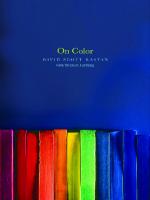Preliminary Results on the Color of Nebulae (1916)(en)(5s)
360 34 657KB
English Pages 5
Recommend Papers

- Author / Uploaded
- Seares F. H.
File loading please wait...
Citation preview
PROCEEDINGS OF THE
NATIONAL ACADEMY OF SCIENCES Volume 2
OCTOBER 15, 1916
Number 10
PRELIMINARY RESULTS ON THE COLOR OF NEBULAE By Frederick H. Seares MOUNT WILSON SOLAR OBSERVATORY, CARNEGIE INSTITUTION OF WASHINGTON Received by the Academy, August 4, 1916
Important differences in the spectra of gaseous nebulae, even those of the same general class, have been known for many years. Although the characteristic nebular lines X 5007 and X 4959 seem to maintain a constant ratio of brightness,* their behavior varies greatly with respect to H#, X 4686, X 3727, and other lines. Thus H, is usually fainter than the chief nebular line X 5007, but there is a wide range in the relative intensities, and intensity reversals may even occur. Again, lines usually present are as yet unobserved in certain objects, and in some we have apparently only the monochromatic radiation X 3727.1 This diversity is reminiscent of the differences in the spectra of stars. These are universally accepted as evidence of evolutionary change, and if nebulae have any part in the scheme of development, it is likely that their spectral peculiarities will find a similar interpretation. In this event spectral correlations must exist, more or less clearly defined according to the development of the nebulae compared. The important investigations of Wright have already revealed relationships presumably of this kind. Further, experience in other fields suggests the probability of spectrum differences within the same nebula. No mixture of luminous vapors is homogeneous in its radiation, for the pressure, temperature, electrical conditions, etc., are never constant throughout. Thus the spectrum changes from point to point in the flame and the electric arc; the radiation from the attenuated gases of a vacuum tube varies with the region examined; and, on a larger scale, the spectrum of the corona, the chromosphere, and the reversing layer-or, even better, spectroheliograms 553
ASTRONOMY: F. H. SEARES
554
for hydrogen and calcium-reveal the selective distribution of vapors within the solar atmosphere. Lack of homogeneity has already been observed in numerous nebulae; but probably the phenomenon is more nearly universal than has hitherto been supposed, and one naturally inquires whether internal differences may not provide useful criteria of development supplementing those based on spectral variations from nebula to nebula. In fact Wright has already called attention, in the case of planetary nebulae, to the gradually increasing concentration of X 4686 within the nucleus as we approach the Wolf-Rayet stars in his graded series of spectra.2 He has made this circumstance a basis for classification, and it seems likely that such criteria will be even more used in the future. Various methods for investigating the constitution of nebulae are available. Measures with a spectral photometer should reveal differ-
-cc(d
27
Io,~ 1(m'
I1
FIG. 1. MESSIER 51.
ences in the distribution of the gases; but few objects are bright enough for an application of the method, which at best-is tedious and uncertain. Monochromatic photographs for each spectrum line can be obtained with a slitless spectrograph or an objective prism; but if the nebula is large, or the dispersion insufficient, the images overlap. The method is useful for planetary nebulae, which are small and relatively bright. For these the ordinary slit spectrograph gives valuable results, the distribution of luminosity being indicated by the length of the lines. That localized in the nucleus produces short lines, while longer lines originate in gases more widely distributed. The method has been used effectively by Campbell, Wright, and Wolf. For a general survey photographs on ordinary and photovisual3 plates should yield useful information. This method was first used by
ASTRONOMY: F. H. SEARES
555
Keeler4 to confirm Campbell's results for the nebula in Orion. It shows admirably, but without differentiation, the distribution of whatever luminosity lies between the limiting wave-lengths determined by the filter and the color curve of the plate. Some refinement of analysis can be effected by using filters of limited transmissibility. Thus Hatt-
:t-trl 1,
is,,
11)"11
Ih
FIG. 2. MESSIER 94.
Secld2 2072
lso
211
FIG. 3. MESSIER 99.
mann6 showed that the great photographic activity noted by Keeler in certain regions of the Orion nebula is due to X 3727, whereas the wider spectral region embraced in Keeler's photographs left the identity of the active radiation in doubt. Again, a red-sensitive plate and a filter transmitting nothing to the violet of X5600 enabled Hale6 to demonstrate the reality of the reddish fringe observed by Barnard, and later by
ASTRONOMY: F. H. SEARES
556
Keeler, along the southern boundary of the Huyghenian Region, and to show that the color was probably due to the Ha line of hydrogen. Spectrum photographs by Adams subsequently placed the matter beyond doubt.6 The usefulness of monochromatic photographs seems thus to have been demonstrated, but it does not appear that they have been employed except for the Orion Nebula. A wider application has therefore seemed desirable, particularly for objects too faint for detailed spectroscopic observation. Among these one naturally turns to the spiral nebulae because of the unexpected result uniformly found for the central region, namely, an absorption spectrum of intermediate or late type. Even admitting the presence of superimposed bright lines, which has in some ;).'2 lM
Jic
,t.'ctl
23.
SI
11
m
-I11
21m
il 1 21 r ,1): FIG. 4. N. G. G. 3242.
cases been claimed, the result is still remarkable for objects whose finer details are suggestive of some of the gaseous nebulae. The illustrations show the distribution of the blue and yellow light in three of the well-known spirals, Messier 51, 94, and 99. The photographs were made with the 60-inch reflector on Seed's '27' and Cramer's 'Instantaneous Isochromatic' plates, the latter exposed behind a yellow filter. The exposure time for yellow light was six times that for blue, in order that the images for the bluer stars might be comparable on the two photographs. Few if any of the yellow images are smaller than the corresponding blue images, at least for objects which are certainly stars; but this is by no means the case for the condensations and nebulosity comprising the branches of the spirals. For these the relative weakness of the
CHEMISTRY: K. G. FALK
557
yellow light is a striking feature for each of the objects mentioned, Quantitative measures of intensity have not yet been made, but there is every reason to believe that the nebular condensations will reveal negative color indices of large amount. The knots of nebulosity are :ertainly bluer than the bluest of the neighboring stars, and one is reminded of the great photographic activity of the central star in the Ring Nebula in Lyra. Whatever the spectral character of these outlying regions may prove eventually to be, it must differ from that of the central nucleus, for the three central nuclei and the secondary nucleus at the end of one of the branches of M 51 are all much stronger in yellow light than in blue. Here the color seems to be in accordance with the typical absorption spectrum found in all similar objects thus far observed. It is still too early for any general conclusion, but preliminary photographs of other spirals suggest similar, results; and it seems not unlikely that the phenomena described are. typical of this class of objects. In contrast to the spirals it is of.interest to note the results for the bright planetary N.G.C. 3242, which is also illustrated. In this instance no important differences are revealed by the blue and yellow exposures, at least none which cannot be accounted for by possible differences in gradation on the two kinds of plates. Newcomb-Engean, Poptulre Astronomie, Fiinfte Aufage, p., 672,. Leipzig, 1914. 2These PROCEEDINGS, 1, 590 (1915). ' An isochromatic plate exposed behind a yellow filter. Astroph. J., 9, 133 (1899). Ibid., 21, 389 (1905). 'An unpublished result obtained in 1909.
1
THE ACTION OF ALKALI IN THE PRODUCTION OF LIPOLYTICALLY ACTIVE PROTEIN By K. George Falk HARRIMAN RESEARCH LABORATORY, ROOSEVELT HOSPITAL, NEW YORK Received by the Academy. August 22, 1916
Introduction.-A summary of an extended experimental study of the lipolytic or ester-hydrolyzing enzymes was presented in these PRoCEEDINGS last year.l The changes in the lipases themselves under various conditions were the main objects of the investigation at that time, as a preliminary to the possible elucidation of the chemical struc. ture of the active groupings. The investigation of the factors which control the loss or destruction of this enzymatic hydrolyzing activity


![The complete color harmony : Pantone edition : expert color information for professional color results [Pantone edition.]
9781631592966, 1631592963](https://ebin.pub/img/200x200/the-complete-color-harmony-pantone-edition-expert-color-information-for-professional-color-results-pantone-edition-9781631592966-1631592963.jpg)






